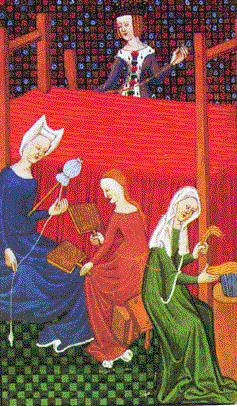Handspinners of the Later Middle Ages and Renaissance
Krystal Morgan
Published Online (2005)
Abstract
Medieval art often depicts handspinners with their distaffs and spindles in bucolic pastoral settings, or working at a great wheel in charming domestic scenes. Pretty as these pictures are, they tend to belie the long hours of work and the low pay that was the reality for many medieval handspinners. A particularly extreme case occurred in Catalonia, where an ordinanace dated 1470 limited a wool spinner’s fee to a maximum of 8 deniers per pound of wool. In 1598, the handspinners of Igualada, near Barcelona, complained to the town councilors that their wages were still limited to 8 deniers per pound of wool, in accordance with the ancient ordinance.
The “Putting Out” System
In France, Italy, England and the Low Countries, the medieval textile industry was generally organized by a “putting out” system, which relied on the use of domestic workers, who used their own tools in their own homes. Typically, a weaver-draper would purchase wool from a wool merchant on credit. The wool would be delivered to the weaver-draper’s home workshop, where his employees (mostly female) sorted, washed and greased the wool. The wool was then “put out” to a succession of domestic workers – – carders or combers. spinners of fluffy warp and tightly twisted weft yarns, warpers and weft winders, all mostly female, mostly earning piece-work wages. Weavers, dyers and fullers were more likely to be male The weavers might be employed by the weaver- draper, or work in their own homes. Finally, the weaver-draper would sell the finished goods to a cloth merchant, and pay the wool merchant from his profits.
Handspinners of the Later Middle Ages and Renaissance
Krystal Morgan
Published Online (2005)
Abstract
Medieval art often depicts handspinners with their distaffs and spindles in bucolic pastoral settings, or working at a great wheel in charming domestic scenes. Pretty as these pictures are, they tend to belie the long hours of work and the low pay that was the reality for many medieval handspinners. A particularly extreme case occurred in Catalonia, where an ordinanace dated 1470 limited a wool spinner’s fee to a maximum of 8 deniers per pound of wool. In 1598, the handspinners of Igualada, near Barcelona, complained to the town councilors that their wages were still limited to 8 deniers per pound of wool, in accordance with the ancient ordinance.
The “Putting Out” System
In France, Italy, England and the Low Countries, the medieval textile industry was generally organized by a “putting out” system, which relied on the use of domestic workers, who used their own tools in their own homes. Typically, a weaver-draper would purchase wool from a wool merchant on credit. The wool would be delivered to the weaver-draper’s home workshop, where his employees (mostly female) sorted, washed and greased the wool. The wool was then “put out” to a succession of domestic workers – – carders or combers. spinners of fluffy warp and tightly twisted weft yarns, warpers and weft winders, all mostly female, mostly earning piece-work wages. Weavers, dyers and fullers were more likely to be male The weavers might be employed by the weaver- draper, or work in their own homes. Finally, the weaver-draper would sell the finished goods to a cloth merchant, and pay the wool merchant from his profits.
Click here to read this article published online by Krystal Morgan
Subscribe to Medievalverse
Related Posts